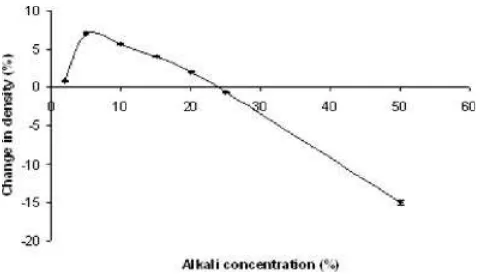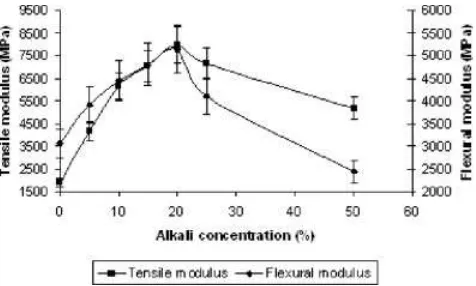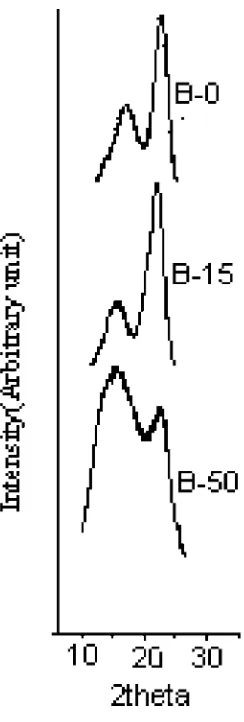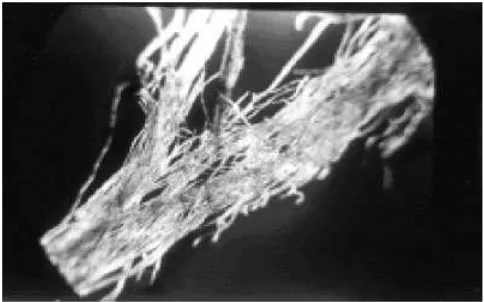Mahuya Das, Debabrata Chakraborty
Department of Polymer Science and Technology, University of Calcutta, Kolkata 700009, India
Received 9 May 2006; accepted 5 January 2007 DOI 10.1002/app.26155
Published online 24 September 2007 in Wiley InterScience (www.interscience.wiley.com).
ABSTRACT: Bamboo strips treated with caustic solutions of different concentrations, e.g., 5%, 10%, 15%, 20%, 25%, and 50%, were subjected to mechanical testing giving stresses on tensile strength, percent elongation at break, flex-ural strength, flexflex-ural modulus, and toughness. The change in average density was 15%, and the weight loss value shows a maximum of 21.94% at 50% alkali treatment. The mechanical properties of bamboo strips increase steadily with increasing concentration of caustic soda, showing a comparable increased value at 15 and 20%, and then exhibit-ing a gradual fall. The percent elongation at break corrobo-rates these observations showing a continuous decreasing trend. The properties under investigation exhibit a clear transition in between 15 and 20% alkali concentration. The
morphology of strips was studied by scanning electron microscope and polarizing light microscope. The crystal structure of both untreated and treated strips was compared by XRD analysis. In both cases, the breakdown of the crystal structures of the cellulose fibers and the recrystallization or reorientation of the degraded chains that are devoid of hem-icellulose are quite apparent. However, at a very high con-centration (to the extent of 25%) the breakdown of structure predominates much more over the reorientation or re-crystallization. Ó 2007 Wiley Periodicals, Inc. J Appl Polym Sci
107: 522–527, 2008
Key words: density; mechanical properties; fibers; orienta-tion; morphology
INTRODUCTION
Attempts are made to utilize properly the lignocellulo-sic fibers, such as jute, sisal, coir, bamboo, pineapple leaf fiber (PALF), broom,1–7etc., as reinforcing agents for composites. These natural fibers have a special advantage of easy availability in comparison to their synthetic opponent. In addition, they are biodegrad-able and renewbiodegrad-able resources and have CO2 neutral life cycle.
Among them, an insignificant amount of work is reported on bamboo, despite of its high strength, low cost, and easy availability. Natural fiber must have a proper interfacial bonding with polymer matrix to be used as a suitable reinforcing agent. The adequate bonding can be obtained only when they are chemi-cally modified.
There are many techniques that can be employed successfully for the chemical modification of natural fiber. Among these techniques, mercerization or alkali treatment is a versatile treatment for chemical modifi-cation. It brings about changes in dimension, fine structure, and morphology of natural fibers.8
Ray and Sarkar,9and Samal et al.10carried out alkali treatment of jute fibers with varying time, concentra-tions, and conditions. Jute fiber with modified tenac-ity, tensile strength, and so forth was obtained. Furthermore, some authors reported changes in crys-tallinity in case of coir and flax fibers due to alkali treatment.11 Improved wettability of coir and sisal fibers were observed by Prasad et al.12and Chand and Rohatgi13 respectively. Bisanda and Ansell14 also noticed the improved resin pick up by sisal fiber after mercerization.
Bamboo has a great potential to be used as a rein-forcing agent in polymeric composites. Such compo-sites can be successfully used as consumer durable goods and for less-intensive load-bearing application. Structure of bamboo was well studied by Amada et al.15 Mechanical properties of bamboo were eval-uated by Nogota and Takahashi16 for the biological application. Jain et al.4,5 and Shin et al.17 studied the strength properties of bamboo fiber reinforced compo-sites. Despande et al.18 invented the method for extraction of bamboo fiber and evaluated the strength properties of composites fabricated with extracted fiber and polyester resin. Das et al. reported influence of mercerization of bamboo fibers on the mechanical properties of bamboo itself19 and bamboo–novolac composites.20
In the present work, an attempt was therefore made to report the changes occurring in bamboo fiber after the treatment with various concentrations (2%, 5%, Correspondence to: D. Chakraborty (debchakrabarty@
yahoo.co.in).
Contract grant sponsor: Council of Scientific and Indus-trial Research, India.
Journal of Applied Polymer Science, Vol. 107, 522–527 (2008) V
NaOH solution of various concentrations (5%, 10%, 15%, 20%, 25%, and 50%). Those strips were dipped for 1 h at ambient temperature. After dipping, the strips were copiously washed with distilled water and subsequently neutralized with 2% H2SO4 solution. Then the strips were dried in an oven at 1058C. From
these dried strips, strands with the dimension of 10 cm1 cm(0.25–0.35) cm were obtained by cut-ting with a manual cutter.
Testing
Average density test
Strips of equal length and width were taken (length 10 cm and width 1 cm). Thicknesses of strips were measured by a Mitutoyo thickness gauge (no. 7301). The average volume and the average mass were deter-mined, and then average density was calculated by using the formula Davg ¼Mavg/Vavg, whereM is the mass of strip and Vis the volume of the strip. Those strips under test were then treated with different con-centrations of NaOH solution, and percent change in density was measured.
Wetting ability test
A drop of water was placed on the treated strips (for every concentration of NaOH) separately and also on the untreated one. The drop was allowed to fall from a burette (0.05 mL). The time required to wet 1 cm dis-tance (previously marked) was noted with a stop watch.20
Percent loss in weight
Strips were weighed separately before treatment and also after treatment followed by necessary washing and drying. The percentage losses in weight were cal-culated as follows:
Average weight of strips before treatment¼W1kg. Average weight of strips as mentioned earlier after treatment with a particular concentration of alkali and drying¼W2kg.
Average loss in weight¼(W1 W2) kg.
Percentage loss in weight¼(W1 W2)100/W1.
Three-point bend tests were performed on bamboo strip samples [101(0.01–0.015) cm3] with an Ins-tron 4304 machine. A crosshead speed of 1.2 mm/min was used. The span length was 4 cm.
XRD study
The XRD pattern was taken on a Philips diffractometer with Cu Karadiation operating at 35 kV and 30 mA and
at room temperature. Samples were in particulate form.
Morphology analysis
A ZEOL scanning electron microscope (JSM-5) and Kruss polarizing light microscope were used to study the fibers and the fracture surface. For scanning electron micros-copy, prior to the analysis, the samples were sputtered with Au/Pd alloy and stuck on a stub by adhesive tape.
RESULTS AND DISCUSSION
The effects of treating the bamboo strips with various concentrations of NaOH on its density are shown Fig-ure 1. A maximum was observed at 5% NaOH solu-tion treated fiber. Beyond 5%, the density decreases continuously. It might be argued that the initial gain in density is possibly due to the removal of the hemi-cellulose and lignin of bamboo, which enables the cel-lulose microfibrils to come closer leading to a better
packing and enhancement of density. The reduction in density at later concentrations of caustic treatment (beyond 5% of NaOH) may possibly be attributed to steady and gradual removal of more and more alkali-sensitive material present in the bamboo matrix, lead-ing to microvoid formation, which appears not to be compensated by the effect of reorientation and conse-quent recrystallization of the cellulose structure pres-ent in bamboo. Varma et al.3reported better packing of cellulose chains with removal of cementing material during alkali treatment of coir fiber. At still higher concentrations of caustic (i.e., 20% and above), the dis-integration and degradation of the a-cellulose itself
causes lowering of densities.
Water, as is well known, possesses a very high sur-face energy (72.06 dynes/cm), and most of the or-ganic resins and solutions have surface energy much lower than that of water, used for testing wetting abil-ity of bamboo strips. Now a surface capable of being wetted by water will definitely allow the water to spread over and through the surface. From Figure 2 it has been revealed that with increasing NaOH concen-tration the wetting ability of the strips is increased, i.e., the surface tension is lowered. It might be
expected that the contaminants present in the strips, which are effective in lowering the surface tension, are removed by NaOH treatment. This decrease in surface tension is conducive to the subsequent wetting. Improved wettability was also observed by Prasad et al.12and Chand et al.13in case of coir and sisal fibers respectively, because of alkali treatment.
The Figure 2 also displays percent losses in weight of bamboo strips as a function of NaOH concentration. The loss in weight is attributed to the gradual and steady removal of more and more cementing material with increasing concentration of NaOH solution. There was a loss of 21.94% at 50% alkali treatment for 1 h at ambient temperature. Ray and Sarkar9observed a maximum loss of 10.45% with 5% caustic treatment at various time intervals.
The effects of mercerization on the mechanical properties of bamboo strip fibers as a function of per-cent conper-centration of alkali used for mercerization are presented in Figures 3–5. From these figures it is clear that tensile strength is maximum at 20% alkali concen-tration, whereas flexural strength reaches maxima at 15% alkali concentration, and at 20% alkali concentra-tion it shows a comparable value. Toughness value follows the same trend of flexural strength value.
Flex-Figure 4 Influence of mercerization on toughness and % elongation at break of bamboo strips.
Figure 5 Influence of mercerization on flexural modulus and tensile modulus of bamboo strips.
Figure 3 Influence of mercerization on tensile strength and flexural strength of bamboo strips.
ural modulus and tensile modulus increase up to 20% alkali concentration and then decrease. Then there is a steady decrease continuously and consistently in all these mechanical parameters up to the level of concen-tration studied.
The percent elongation at break undergoes a decrease, as expected with corresponding increase in tensile strength.
However, it is observed that the mercerized bamboo fibers have superior mechanical properties up to 20% alkali concentration, after which an increase in alkali concentration for mercerization leads to drastic reduc-tion in mechanical properties. This is possibly attrib-uted to the following interaction factors—the alkali-sensitive bonds existing in the different component of bamboo undergoes rupture as a result of penetration and swelling of alkali, and the components like hemi-cellulose starts to get depleted.
Formation of soda cellulose, in presence of alkali and regeneration of cellulose with subsequent neu-tralization,21leads to the formation of new H-bonds between the cellulose chains. Removal of hemicellu-lose releases the initial strain in between the cellulose chains that are normally separated by the
hemicellulose/lignin matrix. As a result, owing to al-kali treatment, the formation of new H-bonds leads to a closer packing of cellulose chains.3 This phe-nomenon is responsible for increased average den-sity and crystallinity index of samples due to alkali treatment.
Crystallinity of the fibers was observed to increase from 45.57% for untreated samples to 51.48% for 15% alkali-treated samples which is also indicated by increased I002 peak height as shown in Figure 6. At 50% alkali concentration inversion of cellulose-I to cel-lulose-II occurred andIIOIpeak height was increased overI002peak. Similar types of observations were also noted by Varma et al.3and Sreenivasan et al.22
From the scanning electron micrographs (Figs. 7–9), it is clear that mercerization leads to rough surface to-pography, and it has been also observed that with increasing alkali concentration the fibers are becoming more and more exposed. In other words, alkali treat-ments lead to fiber fibrillation. Any lignocellulosic ma-terial is composed of multicellular fiber. Each unit cell
Figure 8 Scanning electron micrograph of 10% alkali-treated bamboo fibers.
Figure 7 Scanning electron micrograph of untreated bam-boo fibers.
of fiber consists of small cellulose microfibrils which are surrounded and cemented together with lignin and hemicellulose. Although the length of each cell is very small, they are found to stick to each other in lon-gitudinal direction, thereby producing a long, contin-uous fiber. The neighboring units are also attached among themselves producing a mesh-like structure. Alkali treatment leads to destruction of the total struc-ture reacting with the cementing material, and splits the fiber into finer filament. Fibrillation is the breaking down of the composite fiber bundle into smaller fibers, which leads to a decrease in the spiral angle, i.e., closer to the fiber axis,8 and hence there is an increase in molecular orientation. From polarizing light micrographs (Figs. 10–12), it is clear that with higher alkali concentration the fibers are continuously more and more fibrillated.
From the XRD graph (Fig. 6), it is revealed that there is sufficient amount of randomness in the molecular structure of 50% alkali-treated samples, which lead to decrease in percent crystallinity (17.82%). The ran-domness is probably due to degradation of cellulose
chain itself at higher concentrations of alkali. Well-ori-ented fiber gives better mechanical properties than that of fibers with low or medium orientation. As a result, mechanical properties decrease beyond 20% al-kali concentration.
CONCLUSIONS
The alkali treatment of bamboo fibers with NaOH so-lution showed maximum change in mechanical prop-erties between 15 and 20% alkali treatments. The loss of cementing material results in a more oriented and closely spaced fiber that results in reorientation and recrystallization of cellulose fiber due to alkali treat-ment. But the maximum weight loss due to hemicellu-lose extraction is at 50% alkali concentration, showing extreme changes in some properties like density, wet-ting ability, and resulwet-ting in an extensive fibrillation of fibers. But at that extent of treatment, mechanical properties deteriorate probably owing to degradation of the cellulose chain itself.
Figure 11 Polarizing light micrograph of 20% alkali-treated bamboo fiber.
Figure 12 Polarizing light micrograph of 50% alkali-treated bamboo fiber.
Figure 10 Polarizing light micrograph of untreated bam-boo fiber.
9. Ray, D.; Sarkar, B. K. J Appl Polym Sci 2001, 80, 1013.
10. Samal, R. K.; Mohanty, M.; Panda, B. B. J Polym Mater 1995, 12, 229.
21. Das, M.; Chakraborty, D. J Appl Polym Sci 2006, 102, 5050. 22. Sreenivasan, S.; Bhrama Iyer, P.; Krishna Iywer, K. R. J Mater Sci



